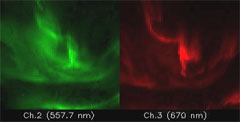|
The development of a scientific satellite in Japan typically takes seven to twelve years. Costs for its development and launch have become higher, and they currently stand at about 12 billion yen and 6 billion yen, respectively. Under such circumstances, the cycle of technological innovation has become longer for satellite technology, and that leads to our bad habit of being conservative in adopting new technology in order to ensure the reliability of an expensive satellite. As scientific satellite development takes such a long time, engineers and researchers of the Institute of Space and Astronautical Science (ISAS) have less opportunities for first-hand experience with a satellite. As a result, it makes it difficult for us to maintain our in-house technology level. Furthermore, the current sense of crisis means we may not be able to maintain healthy space science activities because we lack the means to deal with small-scale science missions that can be left unattended as we have to focus on large-scale high-performance missions. To deal with such a situation, ISAS developed the piggyback satellite "REIMEI" (INDEX, INnovative-technology Demonstration EXperiment ) The purpose of the INDEX satellite project was mainly from an engineering objective to verify cutting-edge satellite technologies in orbit, but, at the same time, it aimed to carry out excellent small-scale space science observations. We developed the three-axis attitude stabilization satellite that weighed some 70 kilograms in about three years, and the cost for the satellite including its bus and mission equipment was about 400 million yen. The INDEX satellite was launched by the Dnepr Russian rocket at 6:10 a.m. on August 24, 2005, from the Baikonur Cosmodrome in the Republic of Kazakhstan and was inserted in the quasi sun synchronous orbit of 98 degrees in inclination and 610 km x 650 km in altitude. The INDEX satellite was nicknamed the "REIMEI," meaning "dawn," to commemorate our dawn of a new era in small-scale scientific satellites. |

Project managerHirobumi Saito
|
|---|
All onboard equipment on the REIMEI is still working properly in space as of May 2008, two years and nine months after liftoff. It also maintains its superb regular attitude control of less than 0.1 degree control accuracy. The REIMEI is one of only a few small satellites that have achieved such a high accuracy of attitude control in the world. Various leading-edge satellite onboard equipment technologies have been successfully verified including engineering missions such as a solar concentrator paddle using a thin film reflector, an ultra small-size GPS receiver, and a flexible and variable radiation rate element. The three-band imager for aurora observations, which is the onboard science mission equipment for detailed aurora observations, acquires clear three-band moving images of aurora by 8 Hz. In addition, the energy analyzer for electron/ion caused by aurora actively measures aurora electron. Furthermore, the REIMEI performs synchronized observations with aurora observations from the ground in Scandinavian countries. A couple of young Japanese researchers will continuously engage in REIMEI operations, using a three-meter antenna on the rooftop of the Sagamihara Campus for aurora observations.
(May 23, 2008 Updated.)